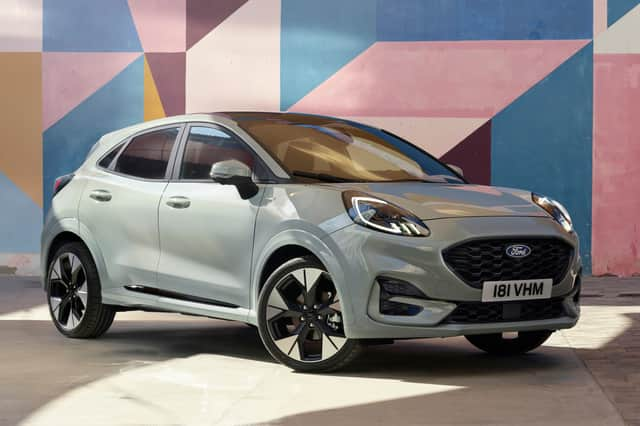Ford gives its popular Puma small SUV a 2024 facelift


Ford has given its sales-topping Puma a midlife update, including a number of external styling tweaks but, perhaps more significantly, a major overhaul in the cabin with improved levels of technology. Order books are open now with first deliveries scheduled for early summer. The entry-level Titanium 125PS Manual will start from £25,790, which represents an increase of just £150 over the current model.
The Puma has, in many ways, become Ford’s ’supermini’, in the way the Fiesta was before its demise. That position puts the Puma head-to-head with a growing number of competitors, including the lines of the Toyota Yaris, Vauxhall Corsa, and even the Nissan Juke.
Advertisement
Hide AdAdvertisement
Hide AdExternally the changes to the new Puma are minimal. At the front there’s Ford’s ‘new’ badge, plus all-new headlights which include a fresh daytime-running light signature. And while the ST-Line spec now gets a more aggressive front bumper, Titanium models get a dechromed front grille. Other external changes include a new palette of colours, including the Cactus Grey (as illustrated).
It’s inside where the biggest changes are noticeable. The cabin is dominated by an all-new dashboard which has been designed to be less cluttered. It benefits from a new wraparound effect, and is enhanced by slim-line air vents and a new two-spoke steering wheel design.
Centre of attention is the new, larger central touchscreen which now contains the controls for more key functions, meaning less physical switches. The digital instrument panel now measures 12.8 inches across and can be customised to prioritise a driver’s preferred information. In addition the infotainment display is a 12-inch panel.
Elsewhere , the refreshed cabin gains synthetic-leather upholstery on the seats, steering wheel and armrest, plus an acoustic laminated windscreen, ambient lighting and an optional panoramic glass roof. Sensibly, Ford has maintained the Puma’s drainable boot-mounted MegaBox, something which has been a top selling point for the car against its competitors.
As for engines, Ford has slightly streamlined the line-up. The core entry unit remains the 1.0-litre three-cylinder EcoBoost petrol engine, and is available with either 123bhp or 153bhp and assisted by a 48-volt mild-hybrid starter-generator. While the larger output is available only with Ford’s seven-speed dual-clutch auto, the 123bhp comes with the choice of the auto’ or a six-speed manual gearbox.
The top of the range units has also been thinned out. Intriguingly, the always highly-rated Puma ST ditches its 197bhp 1.5-litre engine, plus the option of a manual gearbox. The ST will instead only be available with a 168bhp mild-hybrid version of the 1.0 EcoBoost engine and the seven-speed dual-clutch auto transmission. It does, however, benefit from bespoke ST front grilles, the option of a contrasting gloss-black finish for the roof, and most importantly, a Ford Performance splitter that boosts front-end downforce.
Safety has also been enhanced on the facelifted Puma, gaining Reverse Brake Assist (which can stop the car from being reversed into static objects); Rear Cross Traffic Braking, which does the same if it detects people or other vehicles moving across the rear of the car; and Intersection Assist (which watches the road ahead for potential collisions with pedestrians and cyclists).
Comments
Want to join the conversation? Please or to comment on this article.